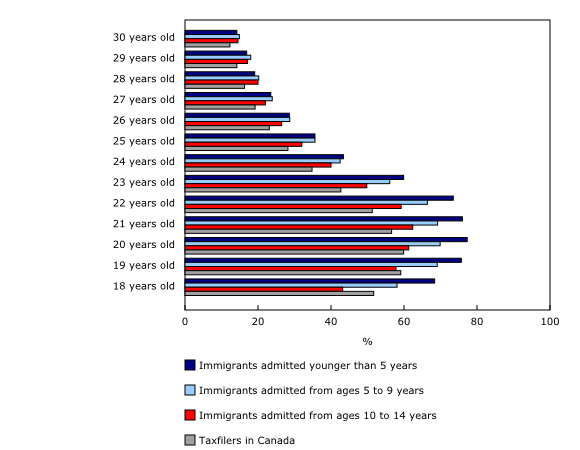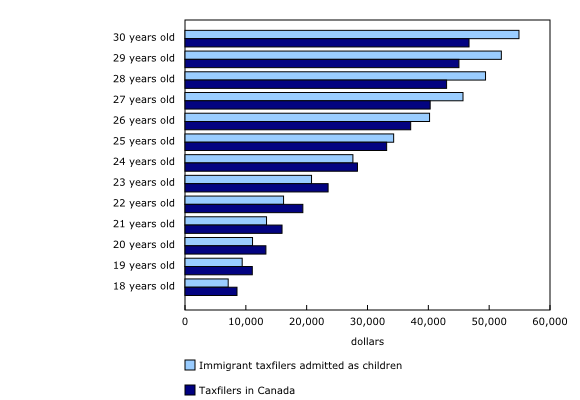Socioeconomic outcomes of immigrants admitted to Canada as children, 2022
Released: 2024-04-09
In 2022, close to 2 million immigrants admitted to Canada since 1980 were children 14 years of age or younger at the time of admission. This represents about one-fifth of immigrants admitted during this period. Immigrants admitted to Canada as children are generally more likely to participate in postsecondary education during early adulthood and report higher median wages at the age of 25 years compared with the reference set by all taxfilers of an equivalent age in Canada.
These findings are from the Longitudinal Immigration Database (IMDB) Children Data Module, which focuses immigrants admitted to Canada as children. It matches immigrants admitted as children with their parental socioeconomic background and provides their tax filing information from the ages of 18 to 30 years. This module allows analysis of the extent to which young adult immigrants' labour market outcomes are associated with their socioeconomic conditions during childhood or early adolescence.
The IMDB is a collaborative effort among Statistics Canada, Immigration, Refugees and Citizenship Canada and the provinces.
Immigrants admitted to Canada as children are generally more likely to participate in postsecondary education during early adulthood and have higher median wages from the ages of 25 to 30 years
In 2021, among young adults aged 18 to 30 years, participation in postsecondary education (measured by whether a person claimed tuition tax credits) was generally higher for immigrants admitted to Canada as children than for the overall Canadian population in the same age group. Broadly speaking, the younger an immigrant child was when admitted, the more likely they were to participate in postsecondary education.
For example, among 20-year-old immigrants, 77.3% of those admitted to Canada at age 4 years or younger participated in postsecondary education, as did 69.9% of those admitted from ages 5 to 9 years and 61.3% of those admitted from ages 10 to 14 years. By comparison, 59.9% of all taxfilers aged 20 years in Canada (which includes both immigrants and non-immigrants) claimed tuition credits for postsecondary education.
Similar trends were observed for most age groups, though notable exceptions were observed among immigrants admitted to Canada from ages 10 to 14 years, who were less likely to participate in postsecondary education at ages 18 and 19 years than all taxfilers at equivalent ages.
Immigrants admitted as children appear to have economically benefitted in the long term from their higher incidence of participation in postsecondary education. In 2021, for example, immigrants aged 18 to 24 years who were admitted to Canada as children had lower median wages than the overall Canadian population in this age group. However, for people aged 25 to 30 years, the median wages of immigrants admitted as children equalled or surpassed those of all taxfilers. By the age of 30 years, immigrants admitted as children had a median wage of $54,900, 17.6% higher than that of all taxfilers in Canada of the same age ($46,690).
Did you know we have a mobile app?
Get timely access to data right at your fingertips by downloading the StatsCAN app, available for free on the App Store and on Google Play.
Note to readers
The Longitudinal Immigration Database (IMDB) team is pleased to announce the release of the 2022 IMDB Children Data Module.
The release also includes a data table (43-10-0075-01) with information on immigrant taxfilers who arrived as children, including their admission cohorts, age at admission, broad admission categories, the number of years lived in a low-income household, and their economic outcomes after reaching adulthood. The data table also includes information on all Canadian taxfilers at equivalent ages to serve as comparative baselines.
The IMDB is a comprehensive data source that provides a better understanding of the economic behaviour of immigrants and non-permanent residents (NPRs). It is the only annual Canadian dataset that allows users to study the characteristics of immigrants to Canada at time of admission and the economic outcomes and regional mobility of immigrants over a period of more than 40 years.
The IMDB is the result of a partnership between Statistics Canada, Immigration, Refugees and Citizenship Canada (IRCC) and the provinces. The IMDB combines administrative files on immigrant admissions and NPR permits from IRCC with tax files from the Canada Revenue Agency. IRCC's administrative records contain extensive information on immigrants admitted to Canada since 1952. They also include information on NPRs who have been granted a temporary resident permit since 1980. Tax returns for immigrant taxfilers for 1982 and subsequent years are available.
The IMDB links short-term and long-term outcomes to characteristics at admission, such as immigrant admission category, country of origin and knowledge of official languages. The IMDB also provides information on pre-admission experience in Canada and citizenship acquisition since 2005.
Results from the IMDB are based on Canadians who have filed a tax return for a given tax year.
For additional information regarding the data coverage and quality of the IMDB, see the "Longitudinal Immigration Database (IMDB) Technical Report, 2022," which is a part of the series Analytical Studies: Methods and References (11-633-X).
This release analyzes income based on the median wages for the population who claimed wage, salary or commission income, excluding self-employment income. The median is the level of income at which half of the immigrant taxfilers have higher income and half have lower. Zero values are not included in the calculation of medians for individuals. All wage estimates are expressed in 2021 constant dollars to factor in inflation and enable comparisons across time in real terms.
Postsecondary education participation is defined as claiming tuition credits for oneself on the T1 tax return (Schedule 11) for the reference year. If the taxfiler was a student during the tax year, they may claim tuition fees (not books or expenses) paid to an educational institution of postsecondary level in Canada. Beginning in 1997, only the qualified total amount of the student is kept in the IMDB. However, any unused part of the tuition amount may be carried forward and claimed in a future year. Any amounts carried forward cannot be transferred to a spouse, parent or grandparent at a later date.
Immigrants admitted as children, also known as Generation 1.5, are immigrants who were admitted to Canada before the age of 15 years. This release analyzes the socioeconomic outcomes of members of this population aged 18 to 30 years.
Data on overall taxfilers in Canada come from the T1 Family File, which uses data from filed tax returns to estimate income and demographic characteristics for the total Canadian population, including immigrants. For more information, users can access the Technical Reference Guide for the Annual Income Estimates for Census Families, Individuals and Seniors, T1 Family File.
Products
The "Longitudinal Immigration Database (IMDB) Technical Report, 2022," is available in PDF or HTML.
The data visualization tools "Longitudinal Immigration Database (IMDB) Interactive Application: Economic Outcomes" and "Longitudinal Immigration Database (IMDB) Interactive Application: Mobility" are available.
The IMDB products are available on the Immigrant and non-permanent resident statistics portal.
The 2022 IMDB Children Data Module is now available upon request.
Contact information
For more information, or to enquire about the concepts, methods or data quality of this release, contact us (toll-free 1-800-263-1136; 514-283-8300; infostats@statcan.gc.ca) or Media Relations (statcan.mediahotline-ligneinfomedias.statcan@statcan.gc.ca).
- Date modified:


